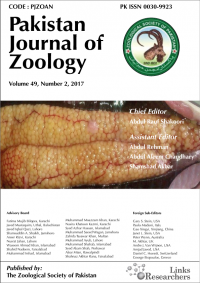Molecular Diagnosis of Theileriosis and Associated Risk Factors in Captive Cervid and Antelope of Punjab, Pakistan
Molecular Diagnosis of Theileriosis and Associated Risk Factors in Captive Cervid and Antelope of Punjab, Pakistan
Muhammad Azhar1, Muhammad Hassan Saleem1*, Muhammad Ijaz1, Ayesha Safdar2 and Kamran Ashraf3
ABSTRACT
Pakistan is home of a wide variety of animal species due to its four unique seasons. Numerous antelope and cervid species have their natural habitats in Pakistan’s deserts, mountain ranges, along the Ravi River and Indus eco-regions. These species can also be found both in the wild and in captivity. We have to face great loses for both known and unknown reasons while keeping these species at different public and private zoological gardens. Hemoparasitic infections particularly theileriosis, transmitted by ticks, are one of the numerous recognized causes of their mortalities. To the best of our knowledge, no research has been done so far on the sero-prevalence and identification of associated risk factors for theileriosis in captive cervid and antelope in our study area. In the current study, the captive endemic species like Axis porcinus, Antelope cervicapra, Gazelle g. bennettii, Ovis vignei, Boselaphus tragocamelus, Ovis orientalis orientalis and Rusa unicolor as well as exotic species including Axis axis, Dama dama and Addax nasomaculatus of cervid and antelope being reared at eleven public and private zoological gardens were included. Out of n=200 samples, n=39 were found positive for Theileria spp through PCR by using 650bp sized primer pair on hypervariable region of 16S rRNA gene. The study also revealed that sex, age, type of enclosure, weather, body condition, chances of ectoparasite infestation and skin coat type were significantly associating with the occurrence of theileriosis in study animals. The study signified the diagnosis and treatment of tick-borne hemoparasitic diseases and proposed the PCR, an authentic technique of diagnosing theileriosis along with simple microscopy.
To share on other social networks, click on any share button. What are these?










